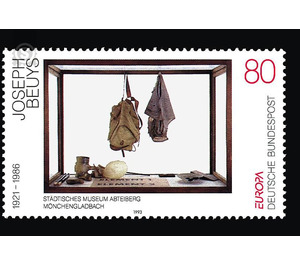Europe - Germany / Federal Republic of Germany 1993 - 80 Pfennig
Theme: Art & Culture
| Country | Germany / Federal Republic of Germany |
| Issue Date | 1993 |
| Face Value | 80.00 |
| Color | white |
| Perforation | K 13 3/4: 14 |
| Printing Type | Multicolor offset printing |
| Stamp Type | Postage stamp |
| Item Type | Stamp |
| Chronological Issue Number | 1546 |
| Chronological Chapter | GER-BRD |
| SID | 737590 |
| In 56 Wishlists | |
Joseph Beuys, born in Krefeld in 1921, is one of the great artistic mummers of our time. Even before his studies at the Dusseldorf Academy (1947-1951, mainly with Ewald Mataré), his work, especially in his drawings, announces a highly independent work, a relationship with the world that breaks standards. Movement = heat = thinking = plastic = change (evolution): Beuys can only realize his »extended concept of art«, in which all levels of reality and imagination, ratio and intuition, sensory and supersensible, permeate themselves with new plastic strategies. He uses an infinite wealth of materials, many previously considered unworthy of art, and in his actions himself as a mobile sculpture, as a carrier. Whether it's drawing, or spacecraft - a flashing of ways to "social sculpture". An immense life's work in number and abundance. The showcases have a special place in this: assembly point, arsenal, focus, place of radiation, passage stage, transparent scenario full of plastic moments and their spiritual connections, allusions and expectations, with relics of actions that, reactivated in changed contexts, appear reactivated. The display case »Lagerplatz« contains u. a. Objects from the action »Manresa« (Galerie Schmela, Düsseldorf) or those sketched in »scores«, such as the backpack, the two air pumps, »Element 1« and »Element 2«. Beuys, impressed by the transformation of Ignatius Loyola through his retreat in the Spanish village of Manresa, performs transformations in his action, in which he asks about the (future) "element 3"; the fragmentary requires supplementation, the combinatorial extension. All showcases make open and secret statements about types of encounters - plastic time: storage, food, heating, transfusion, absorbing and passing on air, forces and counter forces, the elements, passage, departure into the invisible ... Joseph Beuys died in 1986 in Dusseldorf. (Text: Dr. Dierk Stemmler, Director of the Municipal Museum Abteiberg, Mönchengladbach)


